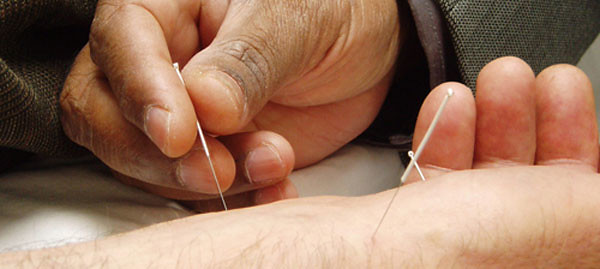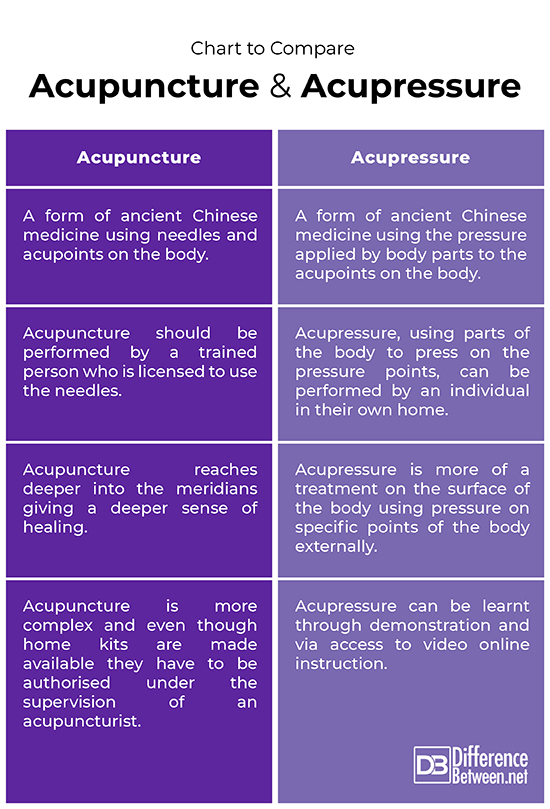Difference Between Acupuncture and Acupressure
Acupuncture and acupressure follow the same principles of using pressure points on the body to help release muscular tension and reduce pain. The pressure points are known as acupoints. The body has hundreds of these acupoints and they are also known as energy points. The energy points are in channels called meridians. Putting pressure on these points helps to open the channels and give relief from pain. The essential difference is acupressure uses manual pressure while acupuncture uses needles, inserted under the skin, to connect with the pressure points. Different parts of the body are used to apply the pressure. Elbows, knuckles, and other parts if the body, exert pressure on the acupoints. Acupuncture is the use of needles to relieve the stress or pressure points. It is believed that acupuncture gives better results because it has a deeper penetration into the blocked meridians.

What is Acupuncture?
Acupuncture is a method used to release pressure and pain in the human body using needles and pressure points. It requires more learning to understand the art of inserting the needles to relieve the stressors felt by the body. A person practising acupuncture must be licensed to be able to practise acupuncture.. It is said that acupuncture is more effective than acupressure. It can be applied to different parts of the body at the same time. This increases the flow of energy more effectively. Acupuncture can be successfully incorporated with modern Western medicine and with chiropractic methods too.

What is Acupressure?
Acupressure has the same aim as acupuncture and is easier to learn. It is often used to treat headaches and migraines. Acupressure is seen to have a positive effect in relieving the side effects of chemotherapy. It has been used as a restorative tool through strengthening the immune system and reducing tension and stress.
The interesting history behind the two practices.
Acupuncture is part of traditional Chinese medicine. It was discovered in medical evidences found in a document known as The Yellow Emperor’s Classic of Internal Medicine. In this document the acupuncture pressure points are noted. These points are still used today in this form of medicine. Acupressure evolved around the same time as acupuncture and together, with other forms of Chinese medicine, are part of TCM or Traditional Chinese Medicine. Both acupuncture and acupressure share the same pressure points and meridians.
Frequently asked questions about these two forms of treatments that sound so similar:
How do you begin the process of either acupuncture or acupressure?
Acupuncture and acupressure specialists start with an in-depth assessment of the patient’s energy levels. They need to understand about sleep patterns, diet, mood and any other imbalances that may upset the energy levels of the person. Answers to questions, and a review of the patient’s medical history, helps the specialist to draw up a profile of the patient.
During the initial stages of the treatment only a few needles are used to see how the body reacts to acupuncture. Acupressure points the patient may be able to use are shared with patients to take home with them and continue on their own.
Are the pressure points in acupuncture and acupressure the same?
There are similarities between these two forms of therapy. The principle behind them is stimulation of the nervous system and the vascular system. The points are not always the same because acupuncture involves the use of needles and may cover a broader spectrum of the body at the same time. Acupressure can be administered by the patient, but the pressure points are limited to the areas a person can reach themselves. Hands and feet for example are widely used pressure points and easily accessible to the patient, and to the qualified acupuncturist.
Are there side effects to this kind of treatment?
There are different side effects experienced depending on the area of the body that is used for the procedure. After a session of acupuncture you may feel sensitive and emotional as acupuncture arouses your body’s self-healing abilities. Many people experience feelings of fatigue and need to rest. Some points on the body may experience a feeling of sensitivity. This particularly applies to the hands and feet. Sometimes the patient may find there is some bruising. Other side effects are emotional release from tension, muscle twitching temporarily, and a feeling of light-headedness. The acupuncturist professional will explain all these possible side effects.
What are the benefits of this type of healing?
Acupuncture is based on the traditional Chinese healing through the insertion of needles to restore balance to the energy levels of the body. There are 350 acupoints in the body. Increasing the flow of energy through these points helps with bringing balance and energy flow back to the body. In 2003 the WHO (World Health Organisation) cited a number of conditions that respond to acupuncture. These include some gastric conditions, high and low blood pressure, nausea and vomiting associated with chemotherapy, rheumatoid arthritis, and even dental pain. Acupuncture is beneficial because the side effects are minimal. It can be combined with other treatments and it can be beneficial to patients who are not able to take pain medication. Acupuncture and acupressure help in the area of pain relief, but as acupuncture is more in-depth, and takes a professional acupuncturist to perform the medical application of needles, it is seen to be more effective overall.
Can you do these types of healing procedures for yourself?
To practise acupuncture you need to be a licenced acupuncturist. However, some acupuncturists will offer to show you how to insert the needles on yourself. They will provide you with an acupuncture kit. If you decide to try this at home work under the guidance of a trained, certified acupuncturist.
Acupressure is easier to do at home because it does not involve needles. There are demonstrations available to follow to find the acupoint needed to relieve pain and stress. The acupoints are easily accessible. This makes acupressure an easier option for home care therapy.
Can acupuncture and acupressure help in areas other than pure medical benefits?
Yes, employers are finding there are benefits to using acupuncture in the workplace. Acupuncture reduces stress levels and is able to reduce stress hormones. There is evidence to suggest acupuncture reduces back pain. It provides relief from neck pain and headaches. There are reports that acupuncture helps lessen eye strain and improves the immune system. A stronger immune system means less time taken for sick leave. There have been reports of increased energy and greater clarity of thinking processes. Acupuncture improves digestive health and lessens the effects of allergies. The overall benefits of acupuncture and acupressure are invaluable in the workplace.
Chart to compare Acupuncture and Acupressure:

Summary of the differences and similarities between Acupuncture and Acupressure.
- The most dominant difference is the fact that acupuncture uses needles and acupressure uses pressure to perform the treatment.
- Acupuncture would appear to be more internal as the needles penetrate the skin. Acupressure is external as body parts like fingers or even elbows are used to apply pressure on the outside of the body.
- Acupuncture requires a specialist to perform the procedure while acupressure can be used in the comfort of your home by anyone who has learnt the art of acupressure.
- Acupressure is compared to reflexology because of the use of outside pressure points to relieve pain.
- Both these forms of medicine originate from China and traditionally relieve pain and stress from illness or trauma.
- Acupuncture is highly recommended in the workplace to improve the wellbeing of employees and improve productivity.
- The value of acupuncture and acupressure lies in the fact that it is a drug free system. It helps symptomatic problems noted in different walks of life from work to home and for emotional and physical ailments.
- This form of medicine is approved by the WHO or the World Health Organisation and this gives acupuncture and acupressure creditability in the medical sector. It is a form of medicine from the East that can be combined easily with Western medical practices.
- Difference Between Lagoon and Bay - October 20, 2021
- Difference Between Futurism and Preterism - August 12, 2021
- Difference Between Dichotomy and Paradox - August 7, 2021
Search DifferenceBetween.net :
Leave a Response
References :
[0]Thakur Vaishnavi. 19.01.2018. www.bebeautifulin.com.Acupuncture and acupressure – Know the difference. Pub. Be Beautiful.
[1]Calabro Sara . 22.04.2013 www.huffpost.com. 7 Acupuncture Side Effects www. pub by Acutake acupuncture directory.
[2]Cary Elea. 17.09.2018. www.healthline.com. 8 Pressure points on your hands. Pub Healthline media.
[3]Image credit: https://live.staticflickr.com/4006/4655596865_f7cf078e49_z.jpg
[4]Image credit: https://pixabay.com/photos/foot-massage-foot-reflexology-2133279/
